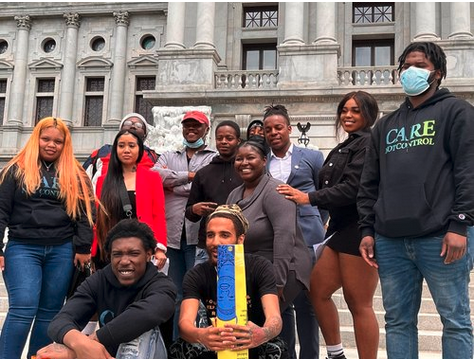
We urge decision-makers to take the following critical first steps* in achieving this goal.
-
Place a moratorium on building or re-opening youth facilities. We call on lawmakers to immediately close or stop the reopening of juvenile detention facilities and youth placement centers.
-
Treat Children As Children:
-
Do not charge youth as adults.
-
- Reinvest public dollars in community based alternatives and improving public safety that does not rely on policing or incarceration.

“I did come out of prison a different person — but I DID NOT come out a better person. I came out more angry, more physically and mentally unhealthy, and more lost than I had ever been.” – young adult formerly incarcerated as a child in adult prison
- Do not build or invest in building new juvenile correctional facilities (including placements or for detention), or separate facilities designed to house youth charged as adults.
- Do not reopen Glen Mills or Wordsworth Academy or any other facility that has been deemed unsafe to house young people.
- Never hold youth in prison-like settings.
- Establish and utilize alternatives to restrictive and prison-like settings for youth who have been deemed to need to be held.
- Until alternatives have been established, utilize the least restrictive and least prison-like settings when holding youth who have been deemed to need to be held.
- Establish, utilize, and sustain alternatives to incarceration in order to safely release and support all youth who are incarcerated in PA.
- Never detain for any period of time young people who meet the following criteria:
- are under the age of 14;
- are charged with a status offense, probation violation, misdemeanor, nonviolent offense, or non-payment of fines, fees or restitution;
- are pregnant or who are parents to children who were born in the past year.
- Only allow for a young person to be temporarily separated from their community if it is determined that (1) the young person’s behavior poses an immediate, specific and substantial risk of physical harm to another person and, (2) no condition or combination of conditions can provide for that young person to be safely returned to the community at the present moment. This determination cannot be made based solely on the type of case a young person is charged with.
“In the future we could work together to build the communities we deserve and create better options. We could fund schools, businesses, gardens, art.” — young adult formerly incarcerated in a juvenile carceral setting
- Invest in and expand the availability of restorative practices to all children with the intent to halt new admissions to the juvenile justice system and end the damage perpetrated by holding youth in carceral settings.
- Require financial savings from removing youth from detention and placement to be invested in evidence-based, community-based and anti-racist alternatives that focus on healing, restorative justice and violence prevention, and are not run/supervised by probation/law enforcement.
- Establish a statewide youth and family advisory group and support county-level advisory groups to ensure that these alternatives and budget allocations are vetted and supported by meaningful youth and family participation.6
- Create financial incentives for counties to create a state fund to help start evidence- and community-based, non-residential programs, and reallocate law enforcement funding to programming, essential needs and services in communities, especially in communities where there are high rates of poverty.
“Prison takes important parts of you that you can never get back—especially when you are young. It forces you to live with horrible things for the rest of your life—some things you’ve seen happen, and some things that have been done to you.” — young adult formerly incarcerated as a child in adult prison
- Amend state law to eliminate the practice of prosecuting youth under age 18 as adults, both through direct file prosecution and the certification/transfer process.7
- In the interim, direct counties to come into compliance with the Juvenile Justice & Delinquency Prevention Act (JJDPA) and the Prison Rape Elimination Act (PREA) by prohibiting the detention of children under 18 in adult jails or prisons for any reason.
